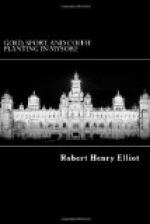There are two kinds, Heb Mitlee, and Harl Mitlee—the second is a bad tree. The mitlee grows one fourth quicker than cub busree, and a recent close attention to this tree shows me that it is a much more desirable tree than either others or myself once supposed, for not only is it a quicker grower than the remainder of the most desirable kinds but its foliage lets in much light. It is, therefore, a most desirable tree for northern aspects.
I next turn to a class of trees which are undoubtedly good for coffee, but which, for various reasons to be hereafter given, are less desirable than the five trees first given. The first of these less desirable trees is the Jack—Halsen-Mara (Artocarpus integrifolia), which was once a favourite tree, and there can be no doubt that coffee thrives well under it, but it is not a wide-spreading tree, the shade is too dense for every aspect, it is a slow grower, and it must be raised from young plants, which are very liable to be attacked by stray cattle. Then when old, and sometimes of medium age, it is very liable to be attacked by parasites; and it produces annually a heavy[53] crop of fruit which costs money and trouble to remove when immature, and which, if left to ripen, exhausts the soil. It is, too, liable to suffer much from wind, and, in situations which are at all windy, is not much to be relied on, as, when under the influence of wind, the foliage becomes poor and scanty, and the tree sometimes dies altogether. A study of the foliage will show, that in one important particular, the five first-named trees are superior to jack, for their leaves are attached to the twigs by long stalks, and much light is thus admitted through the spaces between the stalks, while the leaves of the jack are not only more numerous but are attached by short stalks, and the foliage thus throws a very dark shade. Then jack, as it is an evergreen, always affords a thick shade quite continuously, while the five first-named trees not only cast a chequered shade, but, at certain periods of the year, shed every leaf, leaving the tree quite bare for some time, which is an advantage to the coffee. And besides, I have some reason to suppose that the dense shade of the jack encourages rot (a disease remarked upon further on), as one of my managers reports that he has observed it under jack while it was not apparent on the coffee under other kinds of shade trees. But on hot westerly and southerly slopes, and especially where the soil is a bad retainer of moisture, and where the gradient is rather steep, jack may be used with advantage, as in such situations the heat is great and the light strong. I am therefore taking steps to remove jack by degrees from all but southerly and westerly exposures. I may add here that I have found that plants grown from seed procured from the dry plains of the interior of Mysore, grow more than twice as fast as plants raised from local seed. In concluding my remarks on jack, I would




